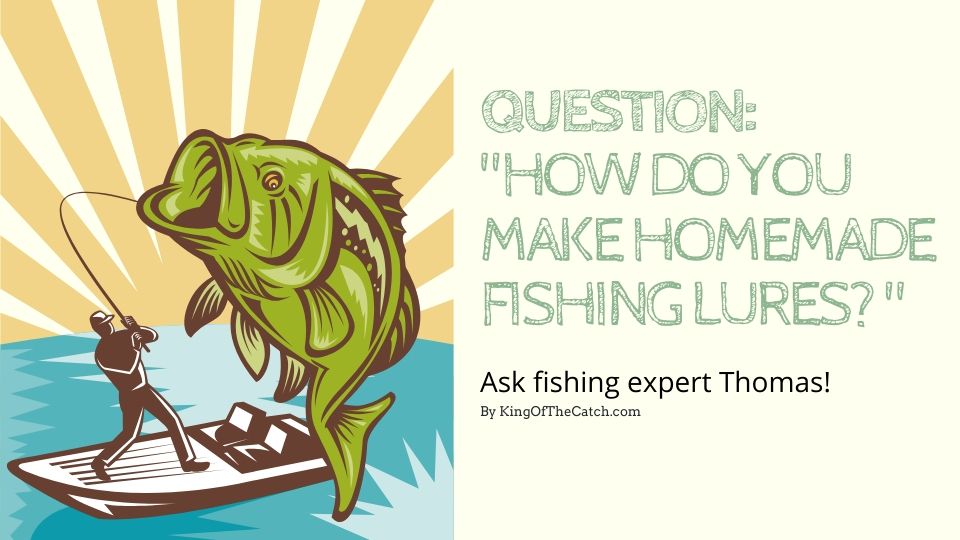Are you planning to go fishing but don’t have the financial means to buy fishing lures? Well, you have got nothing to worry about. You can always learn to make your very own homemade lures with the tools available in your tool shed. With the help of these lures, you can easily catch any saltwater or freshwater fishes.
You get to be your own creative director here on this page.
A lot of people don’t really have the financial means to purchase lures from the market. And making homemade lures is an incredible idea.
You don’t have to worry about emptying your pocket anymore. You can grab a few items at home and make as many lures as you want. Who knows, you just might end up being the king of the catch with the lures you created.
How Do You Make Homemade Fishing Lures?
Hi, I am Zack, 29 from Palatka, Florida, United States, and I have a question. So, I decided that I want to be creative this summer and make my own homemade fishing lures as I am going on a fishing trip with my family soon. Could you guide me through the step by step process of making one of these guys?
Answer: Hello there, Zack. First of all, I am so excited for you to be doing this. It is always productive and brilliant to be making your own homemade lures. You get to have full control and tap into your creativity.
As a fishing geek, I have come across this query a lot in the past.
Before I get into all the details, I want you to know that making any homemade lures requires you to be patient and have a creative thought process. You would want to bring home a big catch, so you have to make your lure with the right measurements and materials. You want to take into account an array of factors as fishes are naturally clever and fast.
Two methods that you can follow to make your very own homemade lures
Wood Technique
You have to cut a block of wood that is somewhat larger than the proportions of your lure. For instance, if you are planning to create a lure that spans 2 inches long and ½ inch wide, you have to cut the block to 2.5 inches long and 1-inch wide. You can utilize a small hand saw for cutting the wood to the dimension of your desire.
You can get the Amazon Bestseller Corona RS 7245 Razor Tooth Folding Saw 7-Inch Curve Blade for cutting the lure. The high-quality teeth and blade will fine-tune your lure.
I advise you to use softwood as they are easy to carve and relatively lighter. You can use softwood such as balsa, basswood, cedar, and also poplar. Now you have to trace the design that was intended for your lure within the block of wood. You can be simplistic and draw long and thin ovals on every long side of the rectangular-shaped block.
Then you can start drawing circles on both the bottom and top squares of the block. The lure will be in rough shape when you are cutting along these lines of the wood block. You can go for a design that is more elaborate if you are going for a special or specific look. The shape of your lure should be ovular and lengthy.
The design you create on your wood should also be round and lengthy. You can sand down lure with sandpaper, later on, so don’t fret about the rough shape for now. You can cut away the parts that you don’t need for the lure with the help of your design. You can utilize a lathe or a carving knife for the next step.
You can first carve off the wood block’s corners and then carve along the block’s sides in the direction of the smaller squares. You can continue the craving process until you land the desired shape of the lure.
In the case of a lathe, you can easily attach and fasten the block to the lathe in a horizontal manner and allow for it to spin. Now you can either lay a carving knife or a wood rasp along the block for trimming away the wood until the wood starts to resemble the lure’s shape.
After the shape of the lure is roughly made, you can sand it down with sandpaper to its intended shape. You can utilize 80-Grit sandpaper for sanding the bigger areas and proceed with 150-Grit sandpaper for fine-tuning the areas that require a little sanding. You can further it down with 220-Grit sandpaper for more tuning.
You can purchase the Dura-Gold Premium for the desired grits to fine-tune your lure. These sandpapers are quite resistant and have a long-lasting cut for exceptional performance.
You have to drill two holes and one hole on the sides and rear of the lure, respectively. The two holes on the side should be placed in the middle and nearby the stomach. The rear hole should be placed at the lure’s end. The hook hangers should be installed in these holes. You can utilize a ¼ inch bit of drill for garnering the best results.
If you want to hang three or more hooks on the lure, then you drill holes accordingly. But I believe three hooks will do the job perfectly fine. You can use epoxy resin to fill the holes with a piping bag before inserting the eye screw into every one of them. Some epoxy might come out when you insert the eye screw. You can utilize a cloth for wiping it off without any issues.
Now you can start applying the epoxy sealer for waterproofing the lure. After you apply it, you have to wait for about 72 hours by hanging the lure in a vertical position. I advise you not to use a water-based sealer, lacquer, and enamel sealers.
It doesn’t do a good job in comparison to the epoxy sealer. The last thing left is to attach the eye screws to the lure. You can utilize pliers for attaching the split rings and the eye screws. You can then slide the hooks onto the rings.
Spoon/Aluminium Technique
You can cut the spoon’s bowl end or the ovular piece that you get from the soda can. You can utilize a hacksaw for cutting the bowl of the spoon and scissors for cutting the soda piece. Make sure to cut the soda piece with measurements up to 1-2 inches for satisfactory results.
You can utilize a metal file for smoothing out the jagged edges of the spoon or aluminum. You can further sand it down with the help of emery cloth. You should utilize a file with medium cuts for satisfactory results. You can get the file from the nearest home improvement store.
Now you have to drill two holes on the item’s two opposite ends. You will attach the hooks to these holes. Some lures tend to carry three doves or more; However, you have drill more than two holes in soda pieces or spoons. It is necessary to maintain the right balance and weight.
Now Pliers should be used to fasten the split rings onto these holes. Since split rings are the tiny form of key rings, you can utilize special pliers for split rings for installing the rings. You can also use needle-nose pliers in place of the special pliers. Split rings spanning from sizes 0 or 1 should be used for the lure.
You can buy the IRWIN VISE-GRIP Long Nose Pliers 6-Inch (2078216) for handling the split rings. It has a ProTouch grip that eliminates hand fatigue and offers extra comfort.
Lastly, you have to fasten a hook to one end of the soda piece or spoon and a swivel on the other one. You have to fasten the hook on the bigger side of the item, and the swivel should be attached to the smaller end of the item. It will prevent the lure from twisting when you are using the fishing line.
Final Tip
You can also use other simple items to create your own homemade fishing lures. For example, you can use corks, pennies, paracords, and many more items to pull this off. The sky is definitely the limit when it comes to homemade lures. You can basically make one with any item available at your disposal.
Good luck! 🙂
Thomas

Niels Thomas is a wildlife expert and fishing fanatic that works with major fishing brands like Deeper Sonar, Abu Garcia, Berkley, PENN, BassPro and Pure Fishing. Through sharing the best fishing tips, tricks, gear reviews, locations and much more he hopes to inspire fishing fanatics to start their own journey towards becoming the King of the Catch!

